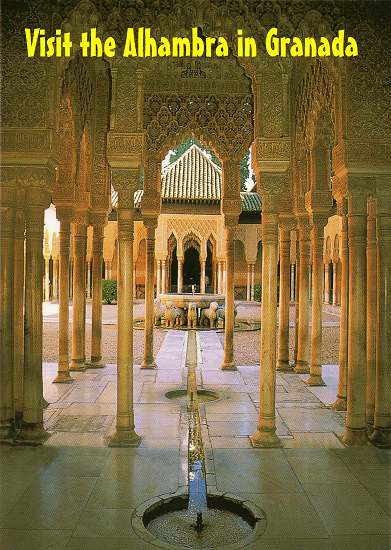
Mixing cultural influences is nothing new in architecture - the Romans mixed with Greeks and Byzantine architecture blended ideas from the West and the East. Likewise, although there are many Nasrid palace rooms in Alhambra, the entire site is often referred to as "the Alhambra Palace." Names of very old structures, like the buildings themselves, often change over time.

As al- generally means "the," saying "the Alhambra" is redundant, yet it is often said.

The name "Alhambra" is generally thought to be from the Arabic Qal'at al-Hamra (Qalat Al-Hamra), associated with the words "castle of red." A qualat is a fortified castle, so the name might identify the sun-baked red bricks of the fortress, or the color of the red clay rammed earth. The "satellite view" on Google Maps gives an excellent overview of the entire complex, including the circular open courtyard within the Palacio de Carlos V. To the east is Generalife, a hillside royal villa outside the Alhambra walls, but connected by various access points. The Alhambra site has been historically rehabilitated, preserved, and accurately reconstructed for the tourist trade. The Museum of the Alhambra is housed in the Palace of Charles V or Palacio de Carlos V, a very large, dominating rectangular building constructed in the Renaissance style within the walled city. The Emperor Charles V (1500-1558), the Christian ruler of the Holy Roman Empire, is said to have torn down part of the Moorish palaces in order to build his own, larger residence. The Christian ruling class during the Renaissance modified, renovated, and expanded Alhambra. Alhambra was expanded into a royal residential palaces or alcazars beginning in 1238 and the rule of the Nasrites, a Muslim domination that ended in 1492. The Alcazaba of Alhambra is one of the oldest parts of today's complex to be reconstructed after years of neglect. No doubt Alhambra we see today was built upon the ruins of other ancient fortifications on this same site - an irregularly shaped strategic hilltop. Michael Reeve/Getty ImagesĪlhambra was first built by the Zirites as a fortress or alcazaba in the 9th century.


Double-click it to open the activities.The Alhambra at Dusk in Granada, Spain. The icon will change its name to "Tales of the Alhambra". Double-click the "desktop" icon and then click "Mark as Trusted". Linux: After downloading, right-click the file and select "Open with 'Wine Program Loader'". A shortcut named "Tales of the Alhambra" will appear on your desktop. Activities: self-correcting comprehension activities and final reader quiz, vocabulary games, a printable book report task and a printable progress report Note: The activities may take some time to download - please be patient! Windows: After downloading, double-click the file and then click "Run".


 0 kommentar(er)
0 kommentar(er)
